Related Research Articles

The Ford Transit is a family of light commercial vehicles manufactured by the Ford Motor Company since 1965, primarily as a cargo van, but also available in other configurations including a large passenger van, cutaway van chassis, and a pickup truck. The vehicle is also known as the Ford T-Series, a nomenclature shared with Ford's other light commercial vehicles, the Ford F-Series trucks, and the Ford E-Series chassis. As of 2015, 8 million Transit vans have been sold, making it the third best-selling van of all time and has been produced across four basic platform generations, with various "facelift" versions of each.

The Volkswagen Taro 1 tonne pickup truck was introduced in January 1989 by Volkswagen Commercial Vehicles to complement the half tonne Caddy pickup / panel van ranges, and the 1 tonne Transporter van and chassis cab ranges. The name "tarō" is a suffix used in Japanese to denote the oldest brother or son, or the first-born son of a family.

The Lorraine 37L or Tracteur de ravitaillement pour chars 1937 L, is a light tracked armoured vehicle developed by the Lorraine company during the interwar period or interbellum, before the Second World War, to an April 1936 French Army requirement for a fully armoured munition and fuel supply carrier to be used by tank units for front line resupply. A prototype was built in 1937 and production started in 1939. In this period, two armoured personnel carriers and a tank destroyer project were also based on its chassis. Mainly equipping the larger mechanised units of the French Infantry arm, the type was extensively employed during the Battle of France in 1940. After the defeat of France, clandestine manufacture was continued in Vichy France, culminating in a small AFV production after the liberation and bringing the total production to about 630 in 1945. Germany used captured vehicles in their original role of carrier and later, finding the suspension system to be particularly reliable, rebuilt many into tank destroyers of the Marder I type or into self-propelled artillery.

The Volkswagen Crafter, introduced in 2006, is the largest three- to five-ton van produced and sold by the German automaker Volkswagen Commercial Vehicles. The Crafter officially replaced the Volkswagen Transporter LT that was launched in 1975, although it is known as the LT3, its production plant code.
The SM Europe was a range of medium/heavy trucks manufactured by the French company Saviem.
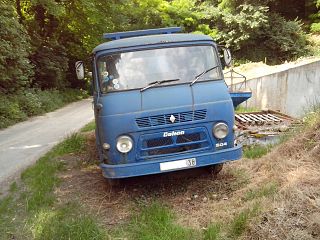
The Saviem Super Galion is a truck under 6 tonnes gross vehicle weight (GVW) produced by the French manufacturer Saviem between 1965 and 1982. It was also marketed as the Renault Super Galion.

The Saviem SM was a range of medium trucks produced by the French manufacturer Saviem between 1967 and 1975.

The Renault 2,500 kg and the Renault Galion were truck/vans with a 2.5-tonne carrying capacity manufactured by Renault between 1947 and 1957 and then by its subsidiary Saviem between 1957 and 1965.
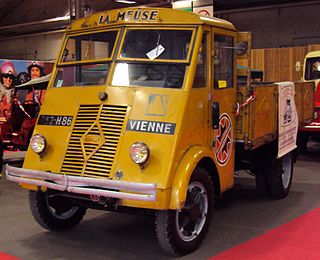
The Renault AHx was a range of light/medium trucks with carrying capacities from 2 to 5 tonnes manufactured by Renault between 1941 and 1947. Various versions were used in World War II by the German forces.

The Tracteur Panhard-Châtillon (French pronunciation:[tʁaktœʁpanaʁ ʃatijɔ̃] was a conventional-cabin, all-wheel drive truck produced between 1911 and 1918 by the French manufacturer Panhard. It was one of the first all-wheel drive trucks used by the French military.
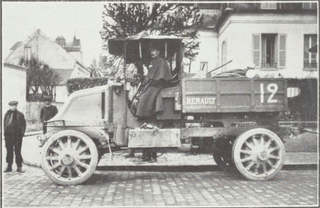
The Renault EG is an all-wheel drive truck/artillery tractor produced between 1914 and 1919 by the French manufacturer Renault.
The Renault AGx was a range of light/medium/heavy trucks produced by the French manufacturer Renault between 1937 and 1941. The range includes both conventional and forward control trucks.

The Renault ACx and ADx is a range of light/medium trucks produced by the French manufacturer Renault between 1935 and 1940. From the range derived some buses.
The Saviem S is a range of medium-duty trucks manufactured by the French manufacturer Saviem between 1964 and 1967.

The early 1930s Renault commercial vehicles were a range of modular chassis produced by Renault, sold under various configurations, primarily trucks, buses and coaches. The range was the first from Renault to get diesel engines and it abandoned previous design styles from the company. The range was gradually replaced from 1935 onwards by the ACx and ADx light range, the ABx medium range and the ZP bus/coach.

The Renault ABx is a range of medium-duty forward control trucks produced by Renault between 1934 and 1937. The range was made of the ABF and the ABG. Renault also developed a bus/coach called the ZP using the same cabin.

The Latil KTL is an all-wheel drive tractor produced by the French manufacturer Latil. It was used as a commercial as well as a military tractor.
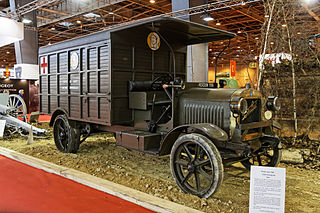
The Berliet CBA is a series of medium-duty trucks with chain drive, initially for the military and later also for commercial use. It was produced by the French manufacturer Berliet from 1913 to 1932, and was one of the most used trucks in World War I. It was replaced by the Berliet GD series.
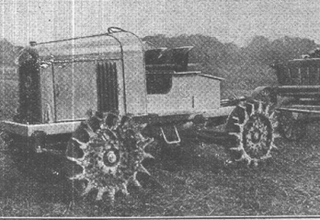
The Latil TL, TL being an initialism, is a multipurpose all-wheel drive tractor produced by the French manufacturer Latil.
References
Citations
- 1 2 Vauvillier, Touraine & Jeudy 1992, p. 71.
- 1 2 Vauvillier, Touraine & Jeudy 1992, p. 93.
Bibliography
- Vauvillier, François; Touraine, Jean-Michel; Jeudy, Jean-Gabriel (1992). L'Automobile Sous l'Uniforme 1939–1940[The Car in Uniform 1939–1940] (in French). Editions Ch. Massin. ISBN 2-7072-0197-9.